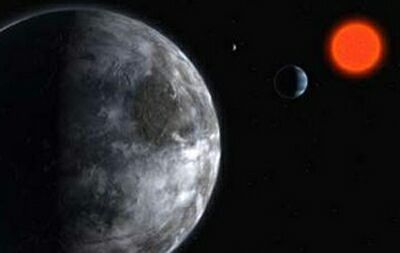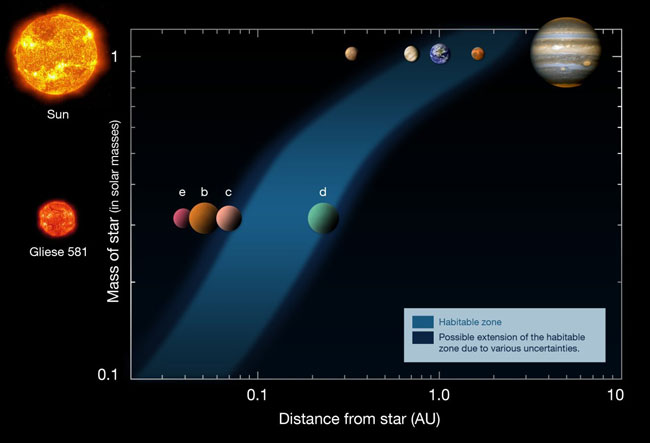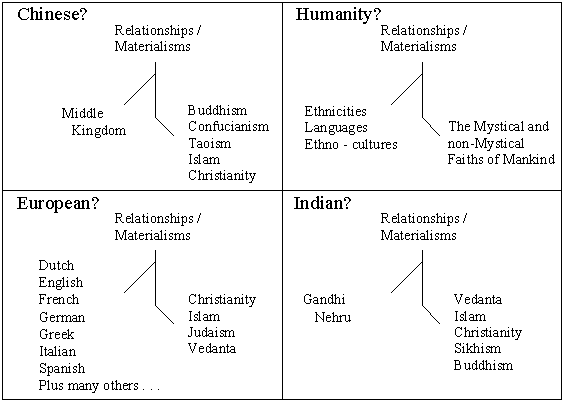Exoplanet Gliese 581 c
Earth-like new planet discovery

|
|
This
artistic illustration released by the European Southern
Observatory on Tuesday, April 24, 2007, shows planets orbiting
the red dwarf star, Gliese 581. Astronomers believe that the
newly discovered planet Gliese 581 c, left, is potentially
habitable.
(European Southern Observatory / AP
Photo) | |
The discovery of a possible new Earth-like planet was announced in late April 2007 by a team of Swiss, French and Portuguese
scientists and astronomers working with the European Southern Observatory in La Silla in the
Chilean Andes. The La Silla facility has a special spectrographic
instrument called the HARPS — the High Accuracy Radial Velocity for
Planetary Searcher that splits light to find wobbles in different
wavelengths. Those wobbles can reveal the existence of other worlds.
Astronomy refers to planets outside our own solar system as exoplanets. Whilst this new earth-like planet, Gliese 581 c,
is not the
first exoplanet to be discovered, (it joins an already discovered 227 exoplanets whose actual existence is deduced
from their influence on nearby stars or through their effects on the light traveling towards Earth, rather than direct
observations), it is the first such
discovery to appear to have a suitable size, a suitably mainly solid composition, and to be located at a
potentially suitable distance from its local star Gliese 581, such that life, "as we know it, Jim", could be supported.
Gliese 581 is a so-called " Red Dwarf " star located in the constellation Libra some 20.5 light years,
(that is 118,000,000,000,000 miles),
from Earth.
Astronomy has discovered three planets orbiting Gliese 581, these are Gliese 581 b, Gliese 581 c, and Gliese 581 d.
The "a" identifier being reserved to avoid confusion with the star itself.
The two planetary neighbours of Gliese 581 c are way bigger planets with Gliese 581 b exceeding the size of Neptune
(i.e. fifteen to seventeen earth masses) in our own solar system and Gliese 581 d being of some eight earth masses.
The Gliese system has now become a focus for future investigation by mainstream space research astronomy.
According to the astronomers from Europe, the planetary system surrounding Gliese 581 in containing no fewer than 3
planets of 15 Earth masses or less, is "a quite remarkable system."
Gliese 581 c appears to measure some 12,000 miles across, compared to Earth at 8,000 miles from pole-to-pole.
This would give this new Earth-like planet a mass some five times that of Earth with consequent increases in local
gravitation pull. Gravity would probably be 1.6 times as strong as Earth's, so a 150-pound object in Earth terms would
upgrade to 240 pounds. Gliese 581 c seems to orbit its local star quite rapidly - giving it what we might consider to be
a thirteen-day "year".
Like our own moon this far
distant "new earth" may also have a "dark side" in that only one face of the planet may be presented to
its red sun as it orbits.
Much of the effort to find Earth-like
planets has hitheto focused on stars like our Sun with the challenge being to find a planet the right distance from
the star it orbits. About 90 percent of the time,
the European telescope had focused its search more on Sun-like stars.
A few weeks before the European discovery of Gliese 581 c, a scientific paper in the journal Astrobiology had theorized
that red dwarf
stars were good candidates for searches for Earth-like planets.
Gliese 581 c orbits its local Red Dwarf star at a considerably closer distance (six million miles) than Earth
orbits our own Sun (ninety-three million miles). The Red Dwarf would appear in the sky as being some twenty times
larger than our moon.
Gliese 581 is quite a dimly glowing star about a third the size of the Sun resulting in a way lower heat output.
It may be that Gliese 581 is fifty times cooler than the Sun.
The lower heat output from this particular Red Dwarf may result in Gliese 581 c being located in a not-too-hot and
not-too-cold
Goldilocks Zone of potential habitability. The Team of astronomers have estimated average temperatures on Gliese 581 c
to be in the range zero to 40 degrees centigrade (32-102 farenheit). Astrobiology - the science which studies
the possibilty of alien life - deems
the presence of liquid water associated with such a goldilocks zone being
a key consideration.
The overall size and seemingly mainly solid composition of this putative new
earth also give rise to
the possibility of the formation of an associated substantial planetary atmosphere with the possibility of the
presence of liquid water.
Its discoverers aren't certain if it is rocky like Earth or if its a frozen ice ball with liquid water on the
surface.
"Liquid water is critical to life as we know it," avows Xavier Delfosse, a member of the team from Grenoble
University (France). "Because of its temperature and relative proximity, this planet will most probably be a very
important target of the future space missions dedicated to the search for extra-terrestrial life. On the treasure
map of the Universe, one would be tempted to mark this planet with an X."

Note: The announcement of April, 2007, of Gliese 581 c as a possible earth-like planet caused widespread interest
but it was subsequently realised that the planet would probably be uninhabitable due to over-heating. The discovery
of a fourth exoplanet in the system - Gliese 581 e - was announced in April 2009 along with the possibility that
Gliese 581 d could be a candidate for recognition as a water world.

|
This diagram depicts the distances of the planets in our own Solar System
(upper row),
and in the Gliese 581 system (lower row), from their respective stars (left)
where 1 AU = the average distance between the Earth and the Sun.
The potentially habitable zone is indicated as the light blue area.
Based on a diagram by Franck Selsis, Univ. of Bordeaux. Credit: ESO
How Does NASA Search For New Planets?
How Do They Find Them?
Read an article by Anna Kucirkova right here:
Nasa and New Planets
| |
Explore "Inner Space"

It is widely known that Plato, pupil of and close friend to Socrates, accepted that Human
Beings have a " Tripartite Soul " where individual Human Psychology is composed of three aspects -
Wisdom-Rationality, Spirited-Will and Appetite-Desire.
What is less widely appreciated is that such major World Faiths as Christianity, Islam,
Hinduism and Buddhism see "Spirituality" as being relative to "Desire" and to "Wrath".
|
|



